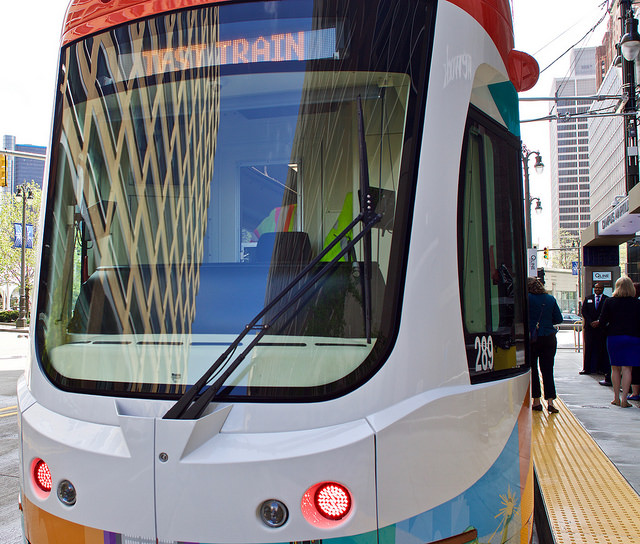When Detroit's QLine streetcar opened last year, the timing was awkward to say the least.
Just a few months prior, voters in the Detroit region had narrowly sided against a ballot measure to fund a cohesive regional transit system. That left Detroiters with the same threadbare bus network that struggles to provide the basics of transit service, and no immediate prospects for improvement.
Enter the shiny $140 million QLine, serving a few thousand riders each day on a short, 3.3-mile downtown route.
Boosters had touted its economic development benefits (they claim it has spurred $7 billion in nearby development), but the Detroit streetcar, like most new streetcars, does little to address the region's major transit shortcomings. It simply doesn't serve that many people. Ridership dropped about 40 percent, to 3,000 trips per day, after the streetcar started charging a $1.50 fare in August.
So how and why did this short streetcar segment rise to the top of regional transit priorities? In a new paper published in the Journal of Planning Education and Research, Kate Lowe and Joe Grengs examine how local government ceded decisions about the project to private benefactors, subordinating public goals to their interests and preferences.
The notion of a Detroit streetcar emerged back in 2006 as the brainchild of regional boosters like Quicken Loans founder Dan Gilbert, the Illitch family (which owns Little Caesar's Pizza), and the Kresge Foundation. Known as the M-1 RAIL committee, they wanted a short downtown circulator to promote economic development. Many of the key backers -- like Gilbert -- were also major land owners along the route.
They offered to pay for the streetcar not only because Detroit was broke, but to circumvent federal regulations they feared would drag out the process.
But they soon decided not to cover all the costs, and enlisted government support. The QLine eventually received $37 million in capital funds from U.S. DOT and another $10 million from the state of Michigan. (A fund established by the private donors supports operations.)
Lowe and Grengs interviewed 15 people involved with the planning and development of the project to assess how critical decisions were made, what led Detroit to opt for a low-ridership streetcar, and how the city's predominantly black transit riders were overlooked.
Other transit options surfaced at various points in the planning process but were rejected. A longer rail route to the city line, for instance, would have connected a more diverse array of neighborhoods to downtown, but the costs were deemed excessive.
A regional bus rapid transit network would have connected even more people to good transit service, and it had the backing of Governor Rick Snyder. The M-1 RAIL committee had different ideas, though, according to sources Lowe and Grengs spoke to.
Committee members didn't think buses would serve their goal of "economic development" very well. One interview subject, cited anonymously, told the researchers that while bus service might have greater utility, "Rich, white people don’t ride buses.”
Once the streetcar option was finalized, the M-1 committee continued to botch key planning decisions. A major debate ensued over whether the streetcar would run in dedicated, center-aligned lanes, maximizing speed and reliability, or in mixed traffic near the curb.
Despite "extensive outreach," the authors write, the ultimate decision came down to the whims of the M-1 RAIL committee. Public comments overwhelmingly favored the center-running approach, but "Gilbert in particular pushed for side alignment," according to the report, which he again believed would be better for economic development. So a slow, curb-running streetcar is what Detroit got.
The M-1 committee's view of the project primarily as "economic development," not an improvement to transit service, is apparent in other ways. The streetcar terminates just a few blocks from the Rosa Parks Transit Center, the city's central bus hub. Better integration could have made the streetcar more useful to bus riders.
Most of the benefits the authors attribute to the M-1 RAIL committee are indirect. The group's enthusiasm for its pet project was used as leverage to obtain other transit priorities. Former Transportation Secretary Ray LaHood insisted that the Detroit region form an integrated urban-suburban regional transit authority before he would award millions for the streetcar.
The Michigan legislature signed off on the RTA in 2012, a milestone in a 40-year struggle. However, the status of the RTA remains unclear after the defeat of the 2016 regional transit ballot measure.
Streetcar supporters argue that by encouraging people to move into the city, the project will help low-income Detroiters indirectly, but the authors don't see that as a substitute for direct investments in transit service the region has failed to make.
"The streetcar does not improve accessibility for transit-dependent populations, who are largely black Detroit residents with needs for connections to regional jobs and opportunities," they write. "Not only will it fail to enhance accessibility, it could harm accessibility through displacing some bus service."






